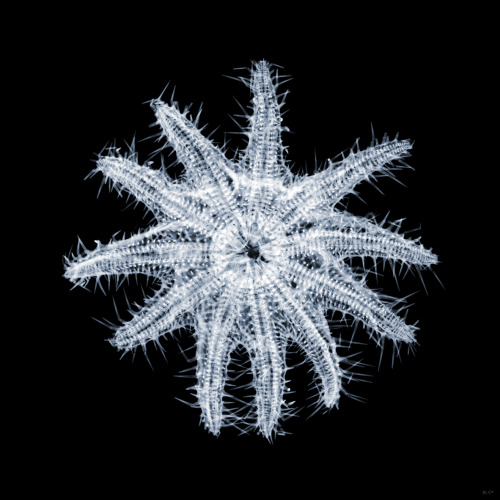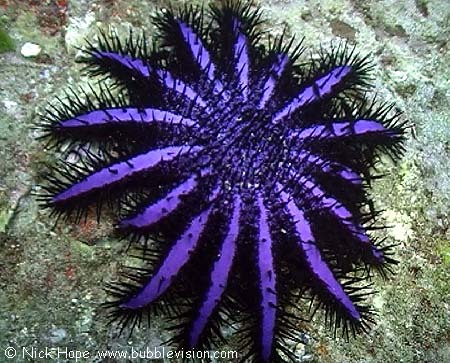
Kingdom: Animalia
Phylum: Echinodermata
Phylum: Echinodermata
Class: Asteroidea
Order: Valvatida
Family: Acanthasteridae
Genus: Acanthaster
Species: A. planci
Phylum Echinodermata: contains about 7000 species and include the starfish, sea urchins, sea cucumbers, brittle stars, and sand dollars
Class Asteroridea: contains all starfish, about 1800 species
Body structure: disk shaped, multiple armed, may have up to 21 arms! heavily spined, grow up to about 35 cm in diameter. usually neutral colours, but can be brightly coloured as well
Digestion: very large stomach, high stomach to body ratio, pulls out its stomach and digests food externally. Quickly eat and swipe away corals and sea urchins, algae, clams, and even each other
 |
| Crown of thorns eating coral |
Respiration: breath through skin, on the aboral side and near the tube feet where surface area is increased, water vascular system also aids in gas exchange
Excretion: excretion of solid wastes through anus on aboral surface and other wastes through the water vascular system (the tube feet)
WATER VASCULAR SYSTEM: water goes into the madreporite, through the stone canal, to the ring canal, and down one of the radial canal, branch out into the tiny bulbs call the ampullae. During this process, the water acts like the starfish's blood, and gives oxygen, carries wastes, and help the starfish move.
Movement: the crown of thorns starfish uses its tube feet to force water in and then out to create a strong suction, it can then use its muscles to move slowly, inch by inch
Reproduction: the crown of thorns starfish have hermaphroditic reproductive structures called gonads (which are the male and female reproductive structures). Sperm are released into the water (external fertilization) and fertilize the eggs when the water goes into the water vascular system (like sponges)
 |
| Teste |
 |
| Ovary |
Symmetry: Asymmetrical, have arms that are not similar, but have the five-point radial symmetry as infants, but eventually more arms grow out
Number of germ layers: The crown of thorns starfish has 3 germ layers (the ectoderm, endoderm, and the mesoderm), or is triploblastic, like all other echinoderms
Other organisms found within this phyla: starfish, sea cucumbers, sea urchins, brittle stars, sand dollars, and sea lilies, and feather stars, these all have similar basic internal structures but have very different external structures and shapes, for example, the reduced arms in the sea cucumber and sea urchin and the brittle stars' long arms
Ecological significance: Does more damage to environment than good. kill off many species of coral, leaving white skeleton behind, the Great Barrier Reef off the coast of Australia was being partially destroyed by these animals, so marine biologists had to inject sodium bisulphate into these creatures, which prove to be fatal to these animals but harmless to the marine environments. These species endanger many other species of coral during massive feeding times in spring. These creatures are becoming more and more common, and the starfish, which were once necessary to keep the numbers of coral in check, is a danger to many areas in the Red Sea, Pacific Ocean, and Indian Ocean.
Deuterostomes or Protostomes: The crown of thorns starfish is a deuterostome, which is due to its embryonic development. Deuterostomes are different from protostomes in the development of the first opening in the blastula, or a more developed stage of the morula. In deuterostomes, the opening becomes the anus and in protostomes the opening becomes the mouth. Deuterostomes contain 4 main phyla, one being the echinoderms and another being chordata, which include all vertebrates.
Other intersting facts:
- The Crown of Thorns Starfish is the 2nd largest starfish in the world, only behind the Sunflower Starfish.
- The Crown of Thorns Starfish can have entire arms filled with their reproductive stuctures
- The ovaries of this starfish can take up a quarter of its body volume and can house 50 million eggs!
- These large starfish can move at 20 km/h at their top speed
- Have toxins called saponins which cause bleeding and severe pain, contained in the spines and break off easily
- These toxins have detergent-like properties and bubble in water
- Can consume 6 square meters of coral a year!
Why I love The Crown of Thorns:
 One, their spikes fascinate me, I always wonder what it will be like to touch one of them, but of course, I don't want to be poisoned by their detergent toxins. Two, they are very, very large starfish, and large things just simply intrigue me for some odd reason. Third, they come in various colours, from bright red, dark blue, to deep chestnut brown and also have indefinite number of arms (to a certain maximum), and I enjoy seeing an organism, or anything, that's out of the ordinary, and doesn't follow specific rules. Fourth, they look like giant durians, which taste amazing. Last, they throw their stomachs out and digest food externally, what's not to love about that?
One, their spikes fascinate me, I always wonder what it will be like to touch one of them, but of course, I don't want to be poisoned by their detergent toxins. Two, they are very, very large starfish, and large things just simply intrigue me for some odd reason. Third, they come in various colours, from bright red, dark blue, to deep chestnut brown and also have indefinite number of arms (to a certain maximum), and I enjoy seeing an organism, or anything, that's out of the ordinary, and doesn't follow specific rules. Fourth, they look like giant durians, which taste amazing. Last, they throw their stomachs out and digest food externally, what's not to love about that? |
| Starfish durian |






No comments:
Post a Comment